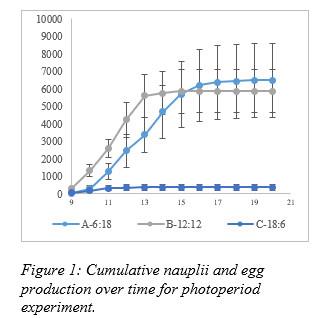REFINING CULTURE METHODS FOR THE CYCLOPOID COPEPOD Oithona colcarva
Marine fin fish can be challenging to culture with many species heavily reliant on small, nutritious live p rey for their first feed. Newly hatched copepod nauplii are an exemplary live feed due to their small size (~45 m) , high nutritional value, and quick escape responses thought to elicit predatory feeding behaviors in larval fishes. The cyclopoid copepod Oithona colcarva is a candidate for aquaculture due to its small size and tolerance to fluctuating c ulture conditions. Experiments were conducted to evaluate initial culture protocols used for O. colcarva production. Culture parameters including diet, stocking density, and photoperiod were assessed to quantify effects on naupliar production.
Initial diet experiments compared different combinations of live micro algae using the species Tisochrysis lutea , Chaetoceros muelleri , and Tetraselmis chuii fed at 400,000 cells/mL. N aupliar production was the highest when adult copepods were fed a 1:1 carbon equivalence ratio of T. lutea and T. chuii . This diet became the control in the following diet experiment examining how algal concentrate blends effect naupliar production . The live microalgae control diet outperformed the algal concentrate diets but further investigations are necessary before ruling out algae concentrat es as potential feeds for O. colcarva.
In the stocking density experiments, adults were stocked at 8, 12, 16, and 24/mL and t here was no significant difference in nauplii production among treatments. Photo period experiments yielded comparable nauplii production between 6-hr light : 18-hr dark and 12-hr light : 12-hr dark . Nauplii production under the 18-hr light : 6-hr dark photoperiod was significantly lower than both other treatments (Figure 1 ). Therefore, natural diurnal cycles should suffice for culture conditions . Results from these experiments were translated to commercial sc ale production in a greenhouse. Commercial scale (200L) production tanks produced an average of 2.56 million nauplii/day for 10 consecutive days. Results from these experiments have contributed to commercial production protocols for O. colcarva, a promising live feed for aquaculture.
